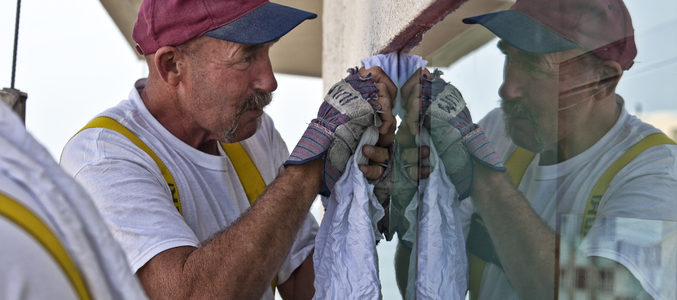A majority of the safety protocols at construction sites originate at the office of the Occupational Safety and Health Administration (OSHA). From preventing slip and falls to detailing how to operate different types of machinery, OSHA requires compliance with its safety standards for general contractors and subcontractors to qualify for licenses. However, implementing some safety protocols means going beyond specific OSHA requirements. One such construction site safety protocol involves the proper disposal of oily rags.
The scientific principle of oily rags spontaneously catching fire is not an urban myth meant to scare workers at construction sites. Spontaneous combustion represents an act in which a fire starts without requiring any help from a match, spark, or lighter. According to the fact sheet released by the National Fire Protection Association (NFPA), an average of 1,700 homes in the United States each year experience a spontaneous combustion reaction. Similar data for construction sites have not become public knowledge, but both subcontractors and general contractors should be aware of the danger and take steps to prevent spontaneous combustion events from happening at work sites.
What is the Chemical Process That Causes Spontaneous Combustion?
Spontaneous combustion appears to materialize out of thin air, as if a magician is playing tricks with our eyes. However, the chemical process behind spontaneous combustion is not a mystery and in fact, it has a simple explanation. Spontaneous combustion develops because of oxidation that forms where heat is trapped. For an oily rag, the oxidation process produces heat and when it reaches an ignition point, the rag suddenly catches fire. After ignition, a fire started by spontaneous combustion can spread rapidly.
How to Prevent the Spontaneous Combustion of Oily Rags
It is essential to prevent the spontaneous combustion of oily rags. You can do this by denying oily rags the oxygen they need to produce heat-generating oxidation works, as well as storing the rags in conditions that prevent the temperature from reaching the flashpoint required for ignition.
How to Dispose of Oily Rags
The safest and most convenient method for storing oily rags is to place them in water inside a metal container that includes a lid. Combining water and a sealed container prevents oxygen from initiating the heat-producing oxidation process. Note that this is not intended to be a permanent solution but only a temporary storage method until you can transport the oily rags to a licensed disposal facility.
Make sure the lid fits tight around the opening to prevent an accidental impact from knocking the lid off the container. Fill the water to the top and ensure the rags remain fully submerged before you place the container in a climate-controlled storage space. You can use stones or other types of heavy objects to keep the rags submerged. Just an exposed corner section of an oily rag can initiate spontaneous combustion. There are also other ways to dispose of oily rags including spreading them out in a safe, flat area to dry. Once they’re dry, check with your city or municipality for proper disposal instructions. Another method of disposal is to take a container of oily rags to your local hazardous waste disposal center, or arrange a special pickup by your garbage pickup service. Many municipalities also host hazardous waste drop-off/pickup days. An important piece to remember is that you should never pour oily water down a drain in or around your work site. Do not wash, recycle, or compost oily rags. Synthetic oil-based products are highly toxic. If washed or composted, the toxic chemicals will then be reintroduced into the environment.
Getting Rid of the Container
To dispose of rags properly from a construction site, take every container to the nearest hazardous waste disposal center. As an alternative, you can also typically schedule a special pickup by a local garbage pickup service. Many cities, especially larger ones, operate hazardous waste drop off and pickup centers on certain days of the year.
Never pour the oil extracted from oily rags down a drain or into the soil located at or near a construction site. Petroleum products possess a high level of toxicity, which means they should never be permitted to enter a local groundwater supply.
How to Dry Oily Rags
Construction sites bustle with activity, sometimes 24 hours per day, seven days a week. Many general contractors do not have the time to dry oily rags, as well as ensure they are disposed of properly. Nonetheless, taking the additional safety precaution step of drying oily rags is worth preventing the development of spontaneous combustion.
Spread oily rags out on the ground or hang them in a single row in an outdoor area that has plenty of ventilation. Place the oily rags on a non-combustible surface, such as concrete or bare soil. It takes about two days for an average-size rag to dry fully before it is ready for disposal. Not only should the rag feel dry to the touch, but it also should not emit any oily fumes.
The Bottom Line
It is not usually one of the priorities at a construction site, but properly getting rid of oily rags can prevent an act of spontaneous combustion that rapidly grows into a raging fire. Construction sites are highly vulnerable to fires starting, which means eliminating one potential source of a fire can keep your project running smoothly.
There for You: Acadia Insurance
At Acadia, we’re all about helping businesses throughout the Northeast thrive. Our mission is to provide superior service and product as close to you as possible, providing you with the backing you need to proceed with confidence.
We understand what you want most from your insurance is security and peace of mind. That means knowing you are backed by an insurance company who will support you every step of the way to help you protect your business.
With Acadia, not only can you get coverage tailored to your needs, but you will also receive support from dedicated claims professionals to guide you through the claim process in the event of a loss. That way, you know exactly what to expect. Knowing your claims professional by name and a hand shake – that’s “Closer Coverage”. Get to know more about how we work and find an agent near you.
Acadia is pleased to share this material for the benefit of its customers. Please note, however, that nothing herein should be construed as either legal advice or the provision of professional consulting services. This material is for informational purposes only, and while reasonable care has been utilized in compiling this information, no warranty or representation is made as to accuracy or completeness. Recipients of this material must utilize their own judgment in implementing sound risk management practices and procedures.




